2019 NISSAN TITAN towing
[x] Cancel search: towingPage 583 of 682
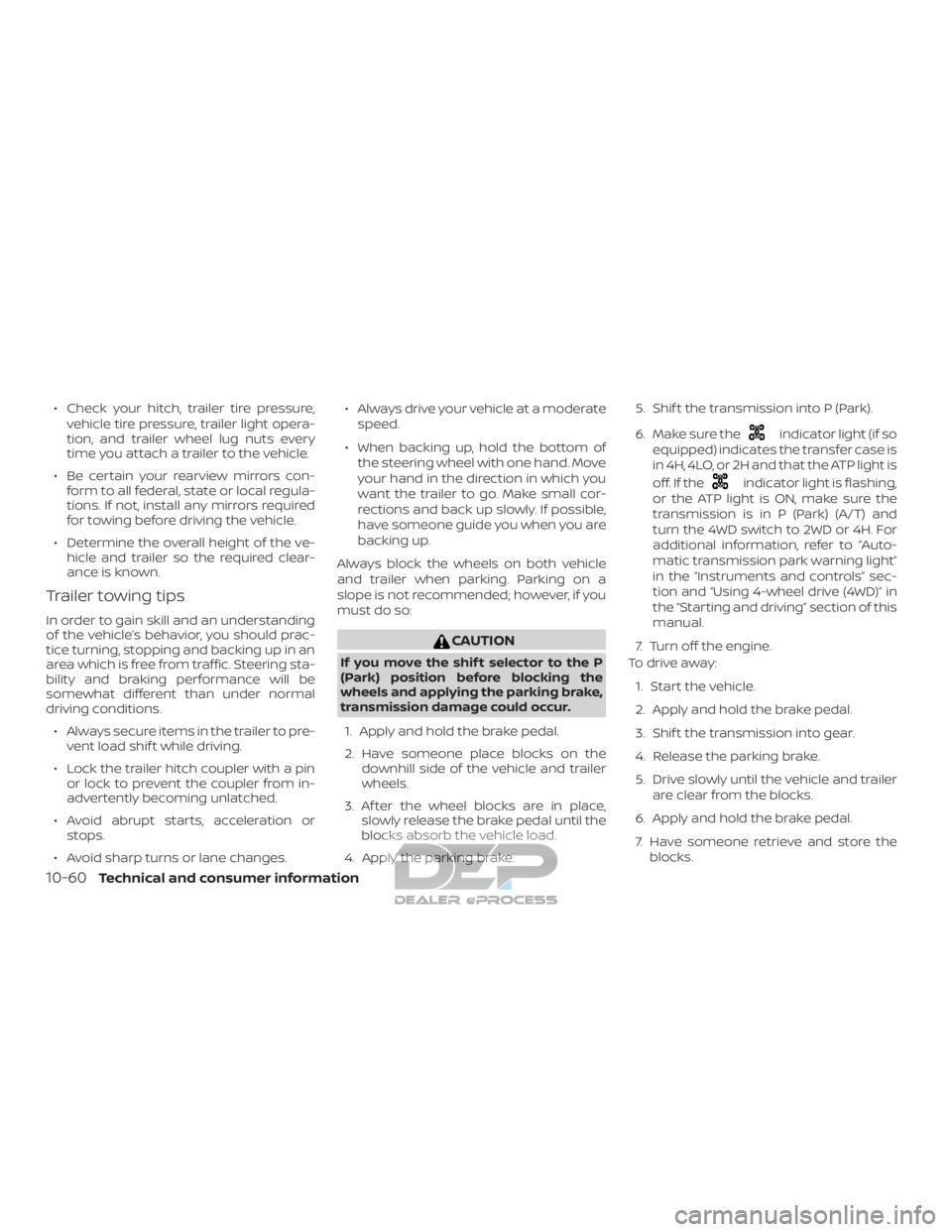
∙ Check your hitch, trailer tire pressure,vehicle tire pressure, trailer light opera-
tion, and trailer wheel lug nuts every
time you attach a trailer to the vehicle.
∙ Be certain your rearview mirrors con- form to all federal, state or local regula-
tions. If not, install any mirrors required
for towing before driving the vehicle.
∙ Determine the overall height of the ve- hicle and trailer so the required clear-
ance is known.
Trailer towing tips
In order to gain skill and an understanding
of the vehicle’s behavior, you should prac-
tice turning, stopping and backing up in an
area which is free from traffic. Steering sta-
bility and braking performance will be
somewhat different than under normal
driving conditions.
∙ Always secure items in the trailer to pre- vent load shif t while driving.
∙ Lock the trailer hitch coupler with a pin or lock to prevent the coupler from in-
advertently becoming unlatched.
∙ Avoid abrupt starts, acceleration or stops.
∙ Avoid sharp turns or lane changes. ∙ Always drive your vehicle at a moderate
speed.
∙ When backing up, hold the bottom of the steering wheel with one hand. Move
your hand in the direction in which you
want the trailer to go. Make small cor-
rections and back up slowly. If possible,
have someone guide you when you are
backing up.
Always block the wheels on both vehicle
and trailer when parking. Parking on a
slope is not recommended; however, if you
must do so:
CAUTION
If you move the shif t selector to the P
(Park) position before blocking the
wheels and applying the parking brake,
transmission damage could occur.
1. Apply and hold the brake pedal.
2. Have someone place blocks on the downhill side of the vehicle and trailer
wheels.
3. Af ter the wheel blocks are in place, slowly release the brake pedal until the
blocks absorb the vehicle load.
4. Apply the parking brake. 5. Shif t the transmission into P (Park).
6. Make sure the
indicator light (if so
equipped) indicates the transfer case is
in 4H, 4LO, or 2H and that the ATP light is
off. If the
indicator light is flashing,
or the ATP light is ON, make sure the
transmission is in P (Park) (A/T) and
turn the 4WD switch to 2WD or 4H. For
additional information, refer to “Auto-
matic transmission park warning light”
in the “Instruments and controls” sec-
tion and “Using 4-wheel drive (4WD)” in
the “Starting and driving” section of this
manual.
7. Turn off the engine.
To drive away:
1. Start the vehicle.
2. Apply and hold the brake pedal.
3. Shif t the transmission into gear.
4. Release the parking brake.
5. Drive slowly until the vehicle and trailer are clear from the blocks.
6. Apply and hold the brake pedal.
7. Have someone retrieve and store the blocks.
10-60Technical and consumer information
Page 584 of 682
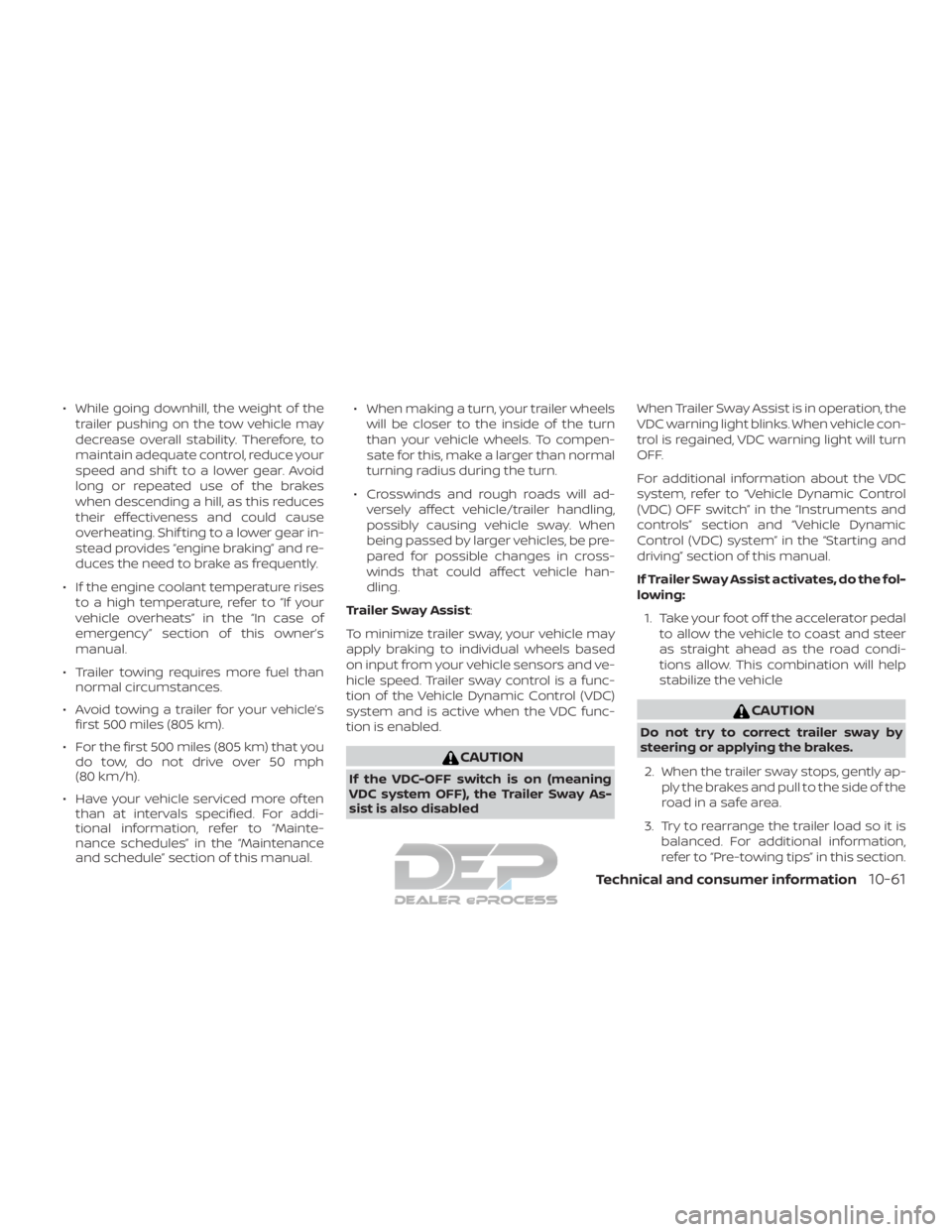
∙ While going downhill, the weight of thetrailer pushing on the tow vehicle may
decrease overall stability. Therefore, to
maintain adequate control, reduce your
speed and shif t to a lower gear. Avoid
long or repeated use of the brakes
when descending a hill, as this reduces
their effectiveness and could cause
overheating. Shif ting to a lower gear in-
stead provides “engine braking” and re-
duces the need to brake as frequently.
∙ If the engine coolant temperature rises to a high temperature, refer to “If your
vehicle overheats” in the “In case of
emergency” section of this owner’s
manual.
∙ Trailer towing requires more fuel than normal circumstances.
∙ Avoid towing a trailer for your vehicle’s first 500 miles (805 km).
∙ For the first 500 miles (805 km) that you do tow, do not drive over 50 mph
(80 km/h).
∙ Have your vehicle serviced more of ten than at intervals specified. For addi-
tional information, refer to “Mainte-
nance schedules” in the “Maintenance
and schedule” section of this manual. ∙ When making a turn, your trailer wheels
will be closer to the inside of the turn
than your vehicle wheels. To compen-
sate for this, make a larger than normal
turning radius during the turn.
∙ Crosswinds and rough roads will ad- versely affect vehicle/trailer handling,
possibly causing vehicle sway. When
being passed by larger vehicles, be pre-
pared for possible changes in cross-
winds that could affect vehicle han-
dling.
Trailer Sway Assist :
To minimize trailer sway, your vehicle may
apply braking to individual wheels based
on input from your vehicle sensors and ve-
hicle speed. Trailer sway control is a func-
tion of the Vehicle Dynamic Control (VDC)
system and is active when the VDC func-
tion is enabled.
CAUTION
If the VDC-OFF switch is on (meaning
VDC system OFF), the Trailer Sway As-
sist is also disabled When Trailer Sway Assist is in operation, the
VDC warning light blinks. When vehicle con-
trol is regained, VDC warning light will turn
OFF.
For additional information about the VDC
system, refer to “Vehicle Dynamic Control
(VDC) OFF switch” in the “Instruments and
controls” section and “Vehicle Dynamic
Control (VDC) system” in the “Starting and
driving” section of this manual.
If Trailer Sway Assist activates, do the fol-
lowing:
1. Take your foot off the accelerator pedal to allow the vehicle to coast and steer
as straight ahead as the road condi-
tions allow. This combination will help
stabilize the vehicle
CAUTION
Do not try to correct trailer sway by
steering or applying the brakes.
2. When the trailer sway stops, gently ap- ply the brakes and pull to the side of the
road in a safe area.
3. Try to rearrange the trailer load so it is balanced. For additional information,
refer to “Pre-towing tips” in this section.
Technical and consumer information10-61
Page 585 of 682
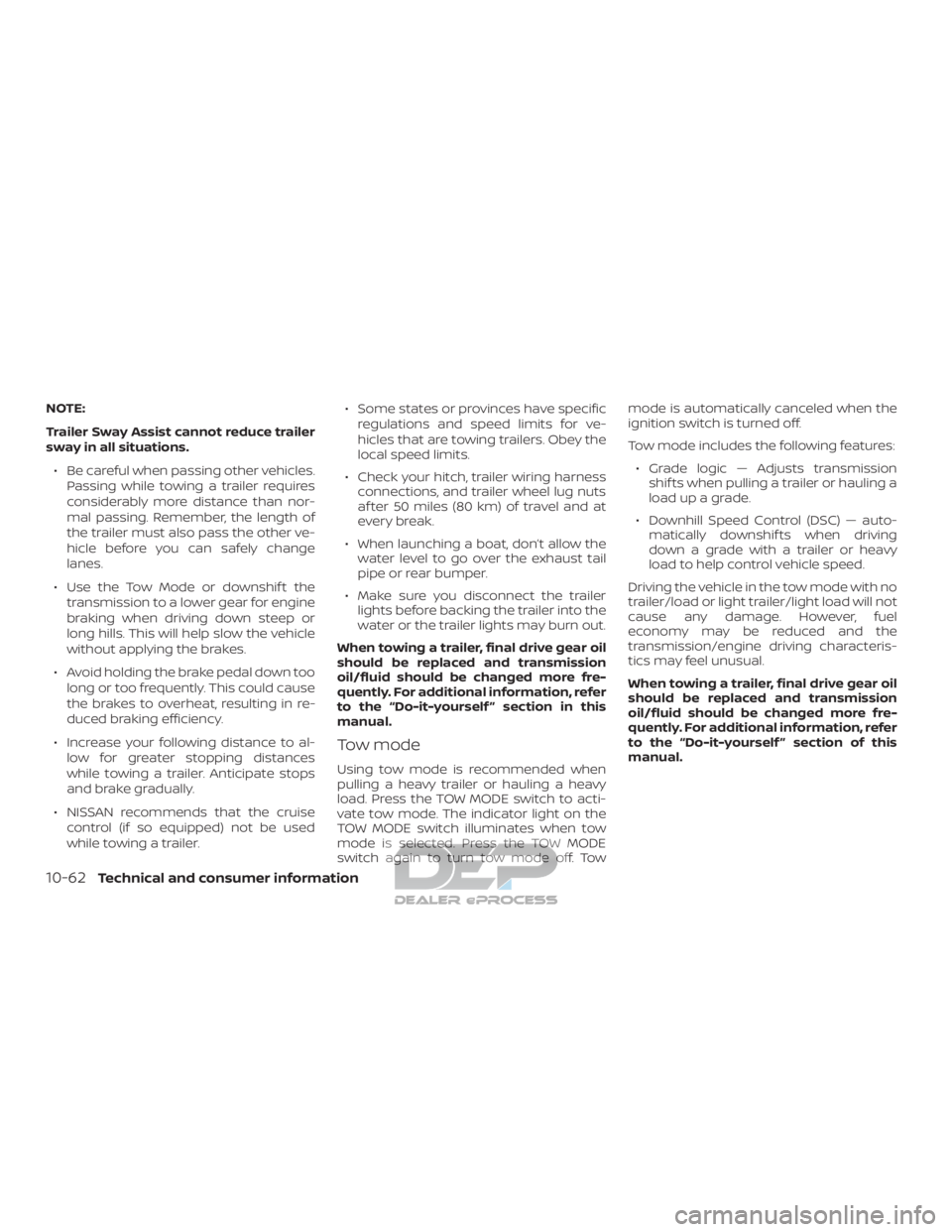
NOTE:
Trailer Sway Assist cannot reduce trailer
sway in all situations.∙ Be careful when passing other vehicles. Passing while towing a trailer requires
considerably more distance than nor-
mal passing. Remember, the length of
the trailer must also pass the other ve-
hicle before you can safely change
lanes.
∙ Use the Tow Mode or downshif t the transmission to a lower gear for engine
braking when driving down steep or
long hills. This will help slow the vehicle
without applying the brakes.
∙ Avoid holding the brake pedal down too long or too frequently. This could cause
the brakes to overheat, resulting in re-
duced braking efficiency.
∙ Increase your following distance to al- low for greater stopping distances
while towing a trailer. Anticipate stops
and brake gradually.
∙ NISSAN recommends that the cruise control (if so equipped) not be used
while towing a trailer. ∙ Some states or provinces have specific
regulations and speed limits for ve-
hicles that are towing trailers. Obey the
local speed limits.
∙ Check your hitch, trailer wiring harness connections, and trailer wheel lug nuts
af ter 50 miles (80 km) of travel and at
every break.
∙ When launching a boat, don’t allow the water level to go over the exhaust tail
pipe or rear bumper.
∙ Make sure you disconnect the trailer lights before backing the trailer into the
water or the trailer lights may burn out.
When towing a trailer, final drive gear oil
should be replaced and transmission
oil/fluid should be changed more fre-
quently. For additional information, refer
to the “Do-it-yourself ” section in this
manual.
Tow mode
Using tow mode is recommended when
pulling a heavy trailer or hauling a heavy
load. Press the TOW MODE switch to acti-
vate tow mode. The indicator light on the
TOW MODE switch illuminates when tow
mode is selected. Press the TOW MODE
switch again to turn tow mode off. Tow mode is automatically canceled when the
ignition switch is turned off.
Tow mode includes the following features:
∙ Grade logic — Adjusts transmission shif ts when pulling a trailer or hauling a
load up a grade.
∙ Downhill Speed Control (DSC) — auto- matically downshif ts when driving
down a grade with a trailer or heavy
load to help control vehicle speed.
Driving the vehicle in the tow mode with no
trailer/load or light trailer/light load will not
cause any damage. However, fuel
economy may be reduced and the
transmission/engine driving characteris-
tics may feel unusual.
When towing a trailer, final drive gear oil
should be replaced and transmission
oil/fluid should be changed more fre-
quently. For additional information, refer
to the “Do-it-yourself ” section of this
manual.
10-62Technical and consumer information
Page 586 of 682
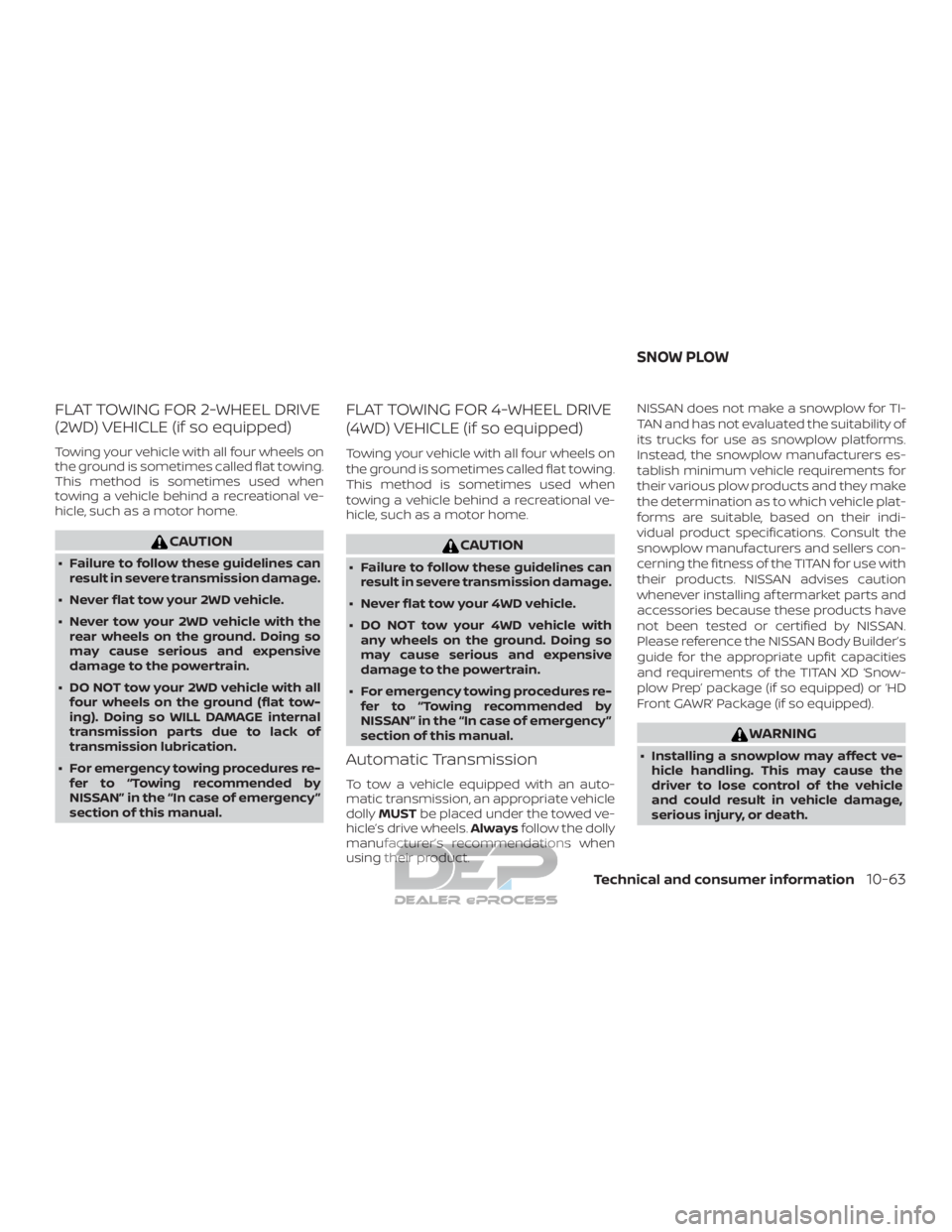
FLAT TOWING FOR 2-WHEEL DRIVE
(2WD) VEHICLE (if so equipped)
Towing your vehicle with all four wheels on
the ground is sometimes called flat towing.
This method is sometimes used when
towing a vehicle behind a recreational ve-
hicle, such as a motor home.
CAUTION
∙ Failure to follow these guidelines canresult in severe transmission damage.
∙ Never flat tow your 2WD vehicle.
∙ Never tow your 2WD vehicle with the rear wheels on the ground. Doing so
may cause serious and expensive
damage to the powertrain.
∙ DO NOT tow your 2WD vehicle with all four wheels on the ground (flat tow-
ing). Doing so WILL DAMAGE internal
transmission parts due to lack of
transmission lubrication.
∙ For emergency towing procedures re- fer to “Towing recommended by
NISSAN” in the “In case of emergency ”
section of this manual.
FLAT TOWING FOR 4-WHEEL DRIVE
(4WD) VEHICLE (if so equipped)
Towing your vehicle with all four wheels on
the ground is sometimes called flat towing.
This method is sometimes used when
towing a vehicle behind a recreational ve-
hicle, such as a motor home.
CAUTION
∙ Failure to follow these guidelines canresult in severe transmission damage.
∙ Never flat tow your 4WD vehicle.
∙ DO NOT tow your 4WD vehicle with any wheels on the ground. Doing so
may cause serious and expensive
damage to the powertrain.
∙ For emergency towing procedures re- fer to “Towing recommended by
NISSAN” in the “In case of emergency ”
section of this manual.
Automatic Transmission
To tow a vehicle equipped with an auto-
matic transmission, an appropriate vehicle
dolly MUST be placed under the towed ve-
hicle’s drive wheels. Alwaysfollow the dolly
manufacturer’s recommendations when
using their product. NISSAN does not make a snowplow for TI-
TAN and has not evaluated the suitability of
its trucks for use as snowplow platforms.
Instead, the snowplow manufacturers es-
tablish minimum vehicle requirements for
their various plow products and they make
the determination as to which vehicle plat-
forms are suitable, based on their indi-
vidual product specifications. Consult the
snowplow manufacturers and sellers con-
cerning the fitness of the TITAN for use with
their products. NISSAN advises caution
whenever installing af termarket parts and
accessories because these products have
not been tested or certified by NISSAN.
Please reference the NISSAN Body Builder’s
guide for the appropriate upfit capacities
and requirements of the TITAN XD ‘Snow-
plow Prep’ package (if so equipped) or ‘HD
Front GAWR’ Package (if so equipped).
WARNING
∙ Installing a snowplow may affect ve-
hicle handling. This may cause the
driver to lose control of the vehicle
and could result in vehicle damage,
serious injury, or death.
SNOW PLOW
Technical and consumer information10-63
Page 597 of 682

SeatsAdjustment ..................1-2
Automatic drive positioner ....3-43,3-45
Frontseats..................1-2
Heatedseats................2-56
Manual front seat adjustment ......1-4
Rearseat...................1-4
Security indicator light ............2-25
Security system (NISSAN Vehicle Immobilizer
System), engine start ..........2-44,5-14
Security systems Vehicle security system .........2-43
Self-adjustingbrakes.............8-22
Service manual order form ........10-68
Servicing air conditioner ...........4-43
Shif ting Automatic transmission .........5-19
Shoulder belt height adjustment ......1-22
Side air bag system
(See supplemental side air bag, curtain and
rollover air bag systems) ...........1-78
Snowplow...................10-63
Spark plug replacement ...........8-19
Spark plugs ...................8-19
Specifications .................10-10
Speedometer ..................2-7
Speedometer and odometer ........2-6
SRS warning label ...............1-80
Stability control ................5-59
Standard maintenance ............9-8
Starting Before starting the engine ........5-15
Jumpstarting............6-14,8-18
Precautions when starting and
driving ..................5-2,5-9
Push starting ................6-16 Starting the engine (diesel only)
......5-16
Starting the engine
(gasoline engine only) .............5-15
Steering Powersteeringfluid............8-12
Powersteeringsystem..........5-55
Steering wheel .................3-30
Stoplight....................8-32
Storage......................2-71
Storagetray...................2-75
Sunglasses case ................2-77
Sunglasses holder ...............2-77
Sunvisors....................3-32
Supplemental air bag warning labels . . .1-80
Supplemental air bag warning
light.....................1-81, 2-22
Supplemental front impact air bag
system ...................1-60, 1-75
Supplemental restraint system Information and warning labels . . . .1-80
Precautions on supplemental restraint
system .................1-53, 1-68
Supplemental restraint system
(Supplemental air bag system) .......1-53
Switch Autolightswitch..............2-50
Automatic power window switch . . .2-85
Electronic locking rear differential (E-Lock)
system switch ...............2-62
Foglightswitch..............2-54
Hazard warning flasher switch ......6-2
Headlightaimingcontrol ........2-52
Headlight and turn signal switch ....2-49
Headlightcontrolswitch.........2-49
Hill descent control switch ........2-61
Instrument brightness control .....2-53Power door lock switch
..........3-7
Powerinverterswitch ..........2-63
Rear sonar system OFF switch .....2-64
T ow
mode switch .............2-65
Turn signal switch .............2-53
T
Tachometer ...................2-8
Tailgate..................3-39, 3-39
Temperature gauge Engine coolant temperature gauge . .2-8
Thef t (NISSAN Vehicle Immobilizer System),
engine start ...............2-44,5-14
Three-waycatalyst...............5-2
Tie down hooks ................3-43
Tire Flattire..................6-3,6-4
Spare tire .............6-5,6-6,8-46
Tire and Loading Information label . .10-21
Tire chains .................8-42
Tire pressure ................8-35
Tirerotation ................8-43
Tires of 4-wheel drive ...........8-45
Types of tires ................8-41
Uniform tire quality grading ......10-64
Wheels and tires ..........8-35,10-11
Wheel/tire size ...............10-11
Tirepressure..................8-35 Low tire pressure warning light .....2-20
Tire Pressure Monitoring System
(TPMS)....................5-3,6-3
Towing 2-wheel drive models ...........6-19
Flattowing.................10-63
11-6
Page 598 of 682
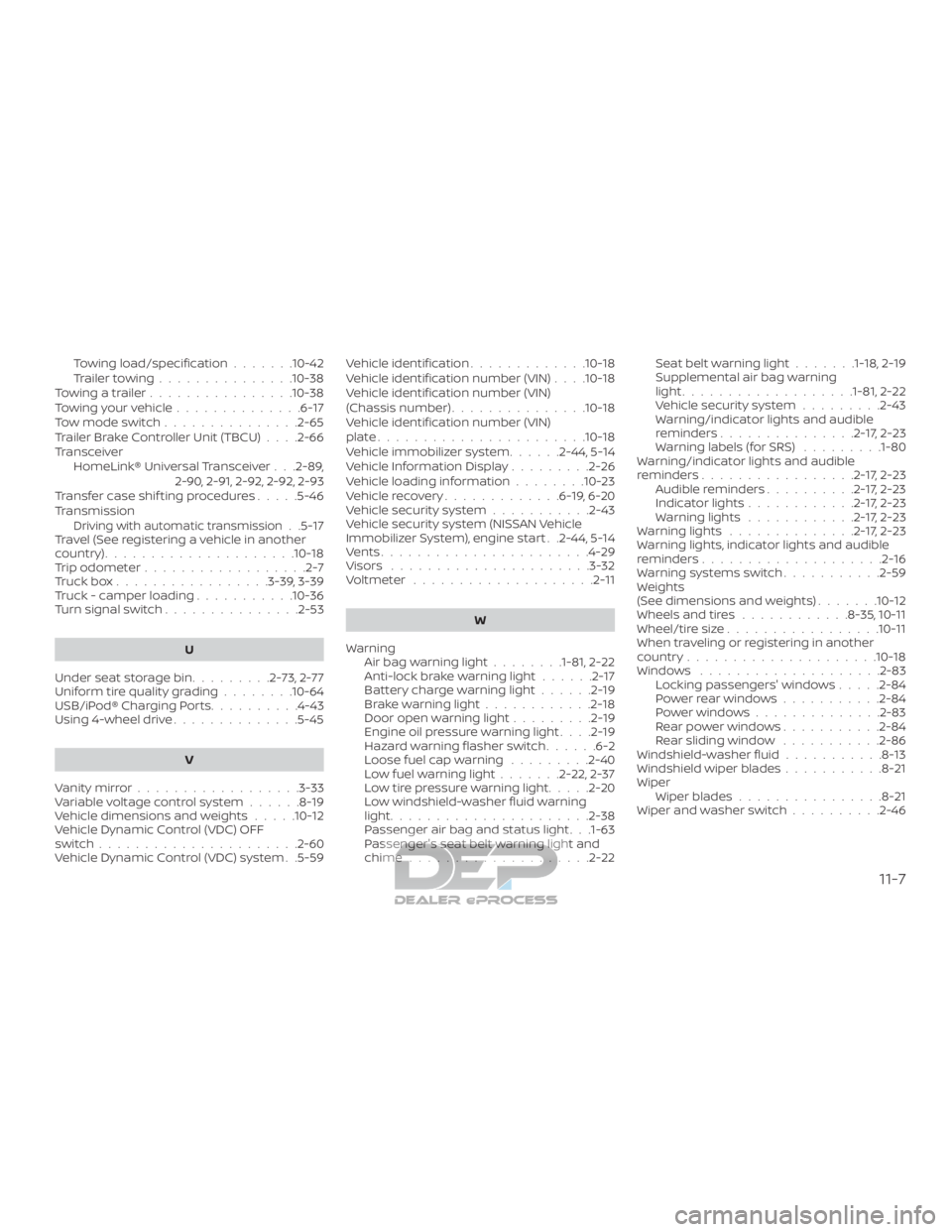
Towing load/specification.......10-42
Trailertowing...............10-38
Towingatrailer................10-38
Towingyourvehicle..............6-17
Tow mode switch ...............2-65
Trailer Brake Controller Unit (TBCU) ....2-66
Transceiver HomeLink® Universal Transceiver . . .2-89, 2-90, 2-91, 2-92, 2-92, 2-93
Transfer case shif ting procedures .....5-46
Transmission
Driving with automatic transmission. .5-17
Travel (See registering a vehicle in another
country) .....................10-18
Trip odometer ..................2-7
Truckbox.................3-39,3-39
Truck - camper loading ...........10-36
Turn signal switch ...............2-53
U
Under seat storage bin .........2-73,2-77
Uniform tire quality grading ........10-64
USB/iPod® Charging Ports..........4-43
Using 4-wheel drive ..............5-45
V
Vanitymirror..................3-33
Variable voltage control system ......8-19
Vehicle dimensions and weights .....10-12
Vehicle Dynamic Control (VDC) OFF
switch......................2-60
Vehicle Dynamic Control (VDC) system . .5-59 Vehicle identification
.............10-18
Vehicle identification number (VIN) . . . .10-18
Vehicle identification number (VIN)
(Chassis number) ...............10-18
Vehicle identification number (VIN)
plate.......................10-18
Vehicle immobilizer system ......2-44,5-14
VehicleInformationDisplay.........2-26
Vehicle loading information ........10-23
Vehiclerecovery.............6-19,6-20
Vehicle security system ...........2-43
Vehicle security system (NISSAN Vehicle
Immobilizer System), engine start . .2-44, 5-14
Vents.......................4-29
Visors ......................3-32
Voltmeter ....................2-11
W
Warning Airbagwarninglight........1-81, 2-22
Anti-lock brake warning light ......2-17
Battery charge warning light ......2-19
Brakewarninglight............2-18
Door open warning light .........2-19
Engine oil pressure warning light ....2-19
Hazard warning flasher switch ......6-2
Loose fuel cap warning .........2-40
Lowfuelwarninglight.......2-22,2-37
Lowtirepressurewarninglight.....2-20
Low windshield-washer fluid warning
light......................2-38
Passenger air bag and status light . . .1-63
Passenger's seat belt warning light and
chime....................2-22 Seatbeltwarninglight.......1-18, 2-19
Supplemental air bag warning
light...................1-81, 2-22
Vehicle security system
.........2-43
Warning/indicator lights and audible
reminders ...............2-17,2-23
Warning labels (for SRS) .........1-80
Warning/indicator lights and audible
reminders .................2-17,2-23
Audible reminders ..........2-17,2-23
Indicatorlights............2-17,2-23
Warninglights ............2-17,2-23
Warninglights ..............2-17,2-23
Warning lights, indicator lights and audible
reminders ....................2-16
Warningsystemsswitch...........2-59
Weights
(See dimensions and weights) .......10-12
Wheels and tires ............8-35,10-11
Wheel/tire size .................10-11
When traveling or registering in another
country .....................10-18
Windows ....................2-83 Locking passengers' windows .....2-84
Powerrearwindows...........2-84
Powerwindows..............2-83
Rearpowerwindows...........2-84
Rearslidingwindow ...........2-86
Windshield-washer fluid ...........8-13
Windshield wiper blades ...........8-21
Wiper Wiper blades ................8-21
Wiper and washer switch ..........2-46
11-7
Page 623 of 682
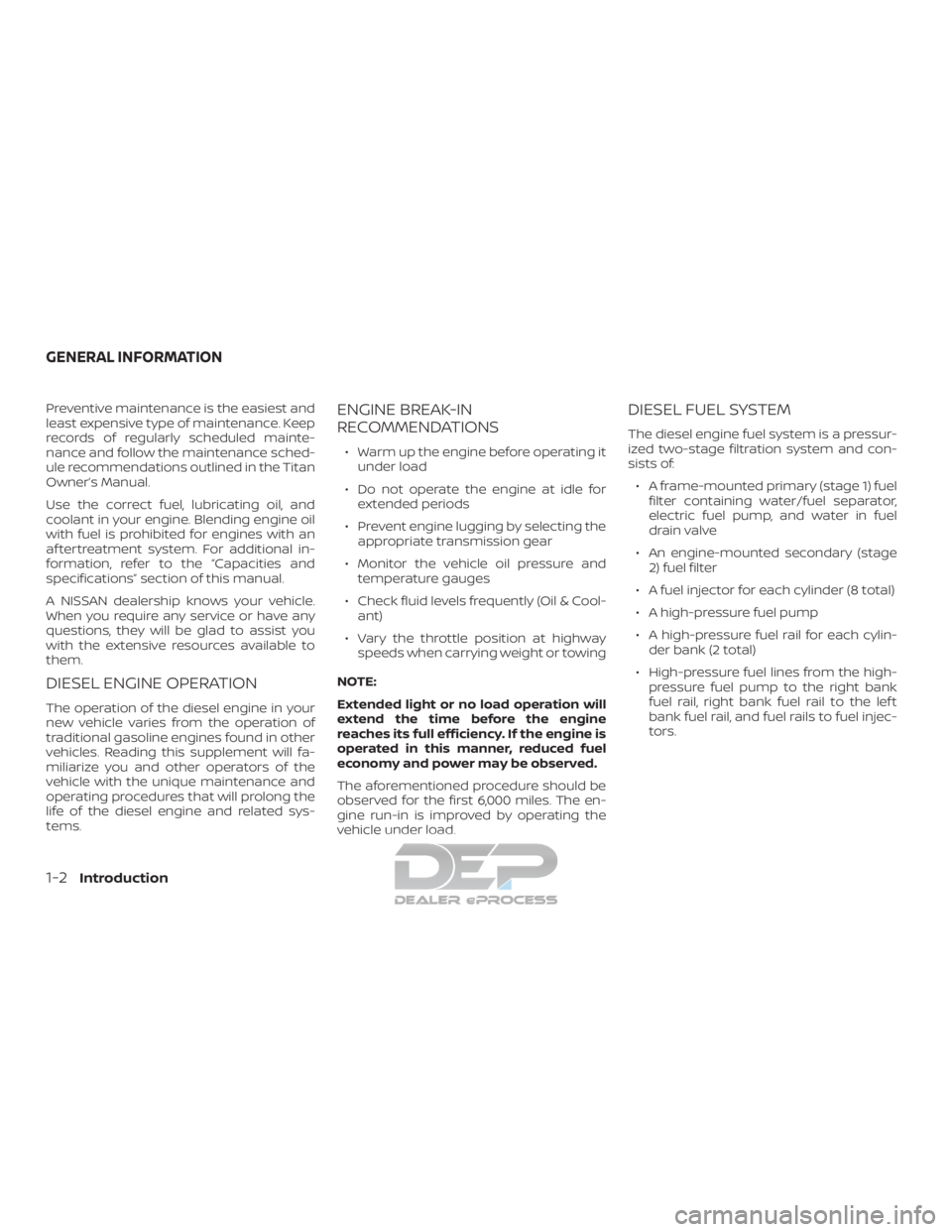
Preventive maintenance is the easiest and
least expensive type of maintenance. Keep
records of regularly scheduled mainte-
nance and follow the maintenance sched-
ule recommendations outlined in the Titan
Owner’s Manual.
Use the correct fuel, lubricating oil, and
coolant in your engine. Blending engine oil
with fuel is prohibited for engines with an
af tertreatment system. For additional in-
formation, refer to the “Capacities and
specifications” section of this manual.
A NISSAN dealership knows your vehicle.
When you require any service or have any
questions, they will be glad to assist you
with the extensive resources available to
them.
DIESEL ENGINE OPERATION
The operation of the diesel engine in your
new vehicle varies from the operation of
traditional gasoline engines found in other
vehicles. Reading this supplement will fa-
miliarize you and other operators of the
vehicle with the unique maintenance and
operating procedures that will prolong the
life of the diesel engine and related sys-
tems.
ENGINE BREAK-IN
RECOMMENDATIONS
∙ Warm up the engine before operating itunder load
∙ Do not operate the engine at idle for extended periods
∙ Prevent engine lugging by selecting the appropriate transmission gear
∙ Monitor the vehicle oil pressure and temperature gauges
∙ Check fluid levels frequently (Oil & Cool- ant)
∙ Vary the throttle position at highway speeds when carrying weight or towing
NOTE:
Extended light or no load operation will
extend the time before the engine
reaches its full efficiency. If the engine is
operated in this manner, reduced fuel
economy and power may be observed.
The aforementioned procedure should be
observed for the first 6,000 miles. The en-
gine run-in is improved by operating the
vehicle under load.
DIESEL FUEL SYSTEM
The diesel engine fuel system is a pressur-
ized two-stage filtration system and con-
sists of: ∙ A frame-mounted primary (stage 1) fuel filter containing water/fuel separator,
electric fuel pump, and water in fuel
drain valve
∙ An engine-mounted secondary (stage 2) fuel filter
∙ A fuel injector for each cylinder (8 total)
∙ A high-pressure fuel pump
∙ A high-pressure fuel rail for each cylin- der bank (2 total)
∙ High-pressure fuel lines from the high- pressure fuel pump to the right bank
fuel rail, right bank fuel rail to the lef t
bank fuel rail, and fuel rails to fuel injec-
tors.
GENERAL INFORMATION
1-2Introduction
Page 671 of 682
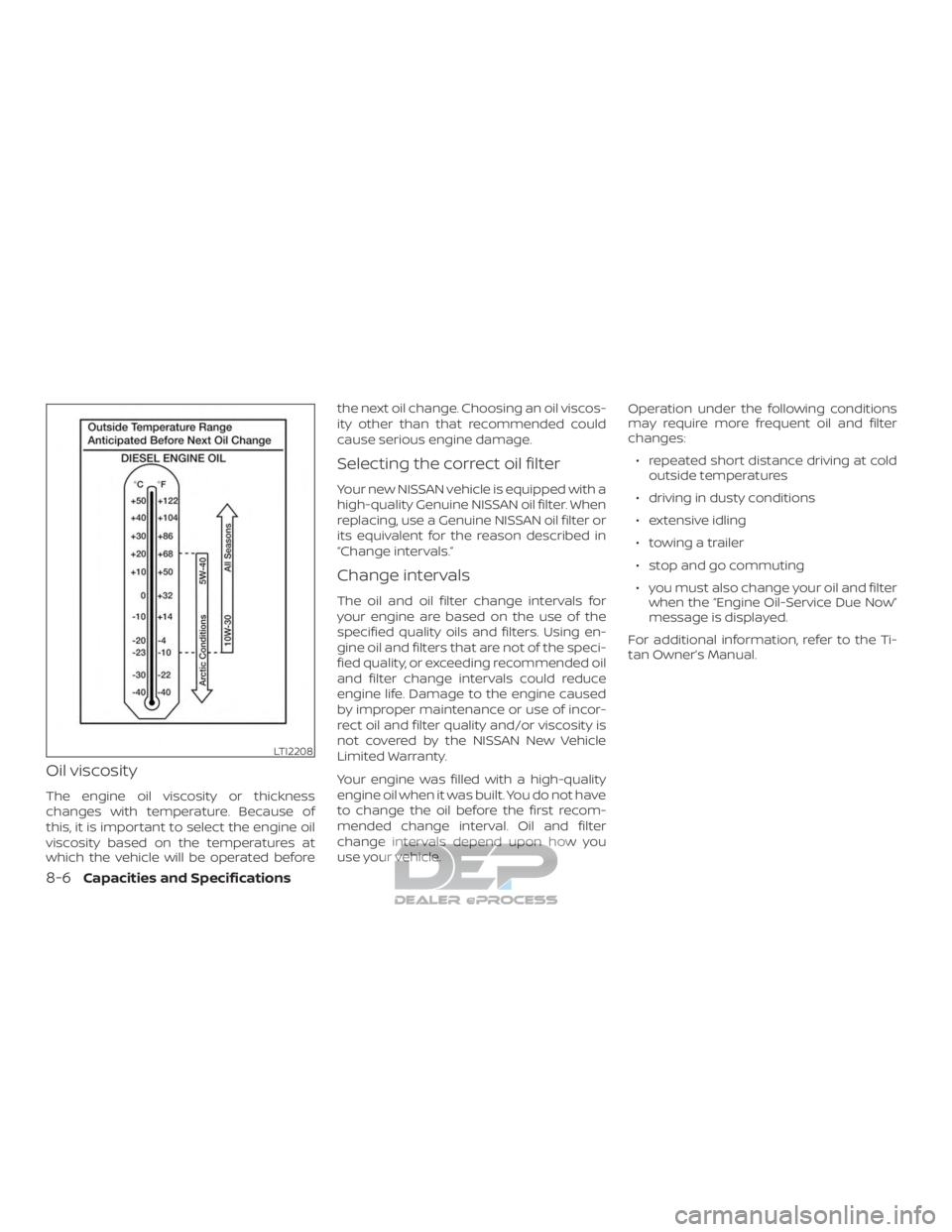
Oil viscosity
The engine oil viscosity or thickness
changes with temperature. Because of
this, it is important to select the engine oil
viscosity based on the temperatures at
which the vehicle will be operated beforethe next oil change. Choosing an oil viscos-
ity other than that recommended could
cause serious engine damage.
Selecting the correct oil filter
Your new NISSAN vehicle is equipped with a
high-quality Genuine NISSAN oil filter. When
replacing, use a Genuine NISSAN oil filter or
its equivalent for the reason described in
“Change intervals.”
Change intervals
The oil and oil filter change intervals for
your engine are based on the use of the
specified quality oils and filters. Using en-
gine oil and filters that are not of the speci-
fied quality, or exceeding recommended oil
and filter change intervals could reduce
engine life. Damage to the engine caused
by improper maintenance or use of incor-
rect oil and filter quality and/or viscosity is
not covered by the NISSAN New Vehicle
Limited Warranty.
Your engine was filled with a high-quality
engine oil when it was built. You do not have
to change the oil before the first recom-
mended change interval. Oil and filter
change intervals depend upon how you
use your vehicle.
Operation under the following conditions
may require more frequent oil and filter
changes:
∙ repeated short distance driving at cold outside temperatures
∙ driving in dusty conditions
∙ extensive idling
∙ towing a trailer
∙ stop and go commuting
∙ you must also change your oil and filter when the “Engine Oil-Service Due Now”
message is displayed.
For additional information, refer to the Ti-
tan Owner’s Manual.
LTI2208
8-6Capacities and Specifications